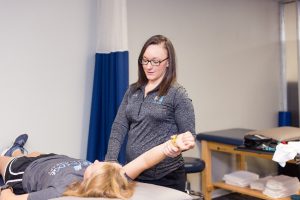Dr. Troy Vander Molen, PT, DPT
In our May newsletter and blog post, I asked the question, “Is the kink in my neck a  pinched nerve?” If you were paying attention, you will remember that the answer essentially was, “Probably not.” While a kink in the neck is always accompanied by localized stiffness, soreness, and difficulty moving the neck, a pinched nerve typically involves symptoms – numbness, tingling, and/or pain – that travel down the arm.
pinched nerve?” If you were paying attention, you will remember that the answer essentially was, “Probably not.” While a kink in the neck is always accompanied by localized stiffness, soreness, and difficulty moving the neck, a pinched nerve typically involves symptoms – numbness, tingling, and/or pain – that travel down the arm.
The natural follow-up questions, then, are these:
If I have numbness, tingling, and/or pain down the arm, does that mean that I have a pinched nerve? Or is it carpal tunnel syndrome?
Good questions!
Technically, the answer to the first question is “yes.” Because nerves carry motor information from the brain to the body and sensory information from the body to the brain, symptoms of numbness and tingling in the arm are likely due to compression of nerve somewhere.
So, the ultimate questions are: What things can compress a nerve? And where does that compression occur?
Back in May, I included this statement in my blog post:
Nerves can potentially be compressed either centrally as they exit from the spine or peripherally by structures like tight muscles that exist external to the spine. Spine-related issues that can put pressure on a nerve as it exits the spine (i.e. central causes) include herniated disks and other arthritis-related changes like narrowing of the disk space, disk degeneration, and bone spurring.
Numbness and tingling in the arm can be caused by compression on a nerve in multitude of areas and from a multitude of sources. The compressive force is not necessarily coming from the neck and may, in fact, be coming from multiple areas.
What structures external to the spine can compress a nerve and cause numbness and tingling?
There are many structures that can compress a nerve as it travels from the brain to the terminal body part. Compression from one or more of the structures along the pathway of the nerve can contribute to a variety of arm symptoms.
There is a condition called double crush syndrome. With this condition, there is increased nerve symptom intensity due to distinct compressive forces along the pathway of the nerve at two or more locations. Double crush syndrome can lead to diagnoses like carpal tunnel syndrome (CTS) or thoracic outlet syndrome (TOS), which don’t fully explain the root cause of the problem and can lead to expensive and often ineffective treatments.
Because of double crush syndrome, treatment of arm numbness and tingling must be comprehensive. If you have been told that you have carpal tunnel syndrome, you may have been led to believe that you have pressure on your nerve at the carpal tunnel of the wrist. You may even have gone through a diagnostic test of nerve conduction velocity (i.e. NCV or EMG) that “proved” that you have pressure on the nerve at the wrist.
But, in the words of ESPN football analyst Lee Corso, “Not so fast, my friend!”
The key to successfully treating any condition that is causing numbness and tingling in the arm is to assess and correct any of the structures that can place a compressive force on the nerve throughout its entire pathway.
Here are the primary culprits that must be cleared to ensure that you eliminate peripheral nerve compression and numbness/tingling in the arm.
As the nerves pass from the neck to the fingers, they pass through many structures. At the origin of the nerves, this bundle of nerves (known as the brachial plexus) passes through the scalene, which are muscles that run from the upper part of your neck to the first rib. Tightness of this muscle group will compress the nerve bundle, which can manifest as numbness and tingling down the arm.
COLLAR BONE
When the scalene muscles are tight, the first rib may elevate, which further compresses the nerve bundle. Furthermore, a forward head/rounded shoulders posture (see pec muscle information below) and weight gain can further increase the mechanical compressive forces in this area.
PECTORAL MUSCLES
Our chest muscles are comprised of the more superficial (and visible) pec major and the underlying pec minor. These muscles travel from the sternum and the front of your rib cage and connect on a bone that projects forward from your shoulder blade (the coracoid process).
As the nerve bundle and accompanied blood vessels travel distally down the shoulder into the arm, branches of these nerves are positioned beneath the pec minor. You will typically know that the pec minor is tight because you will see that the shoulder is rounded, or hunched. This problem, by the way, can also cause shoulder problems because of increased compressive forces on the rotator cuff tendons and a bursa in that region
For a great summary of how to manage this issue, check out this article by Daniel Stern and Shannon McKenna of Cirque Physio.
If you are concerned about numbness and tingling in the arm and have wondered whether you have carpal tunnel syndrome or thoracic outlet syndrome, I encourage you to take advantage of our free injury screens. Take a test drive for FREE by scheduling a brief and complimentary 20-minute consultation with one of Kinetic Edge’s movement experts, and you can get simple answers to your musculoskeletal problems. Call 866-588-0230 today to claim one of our few open slots.




